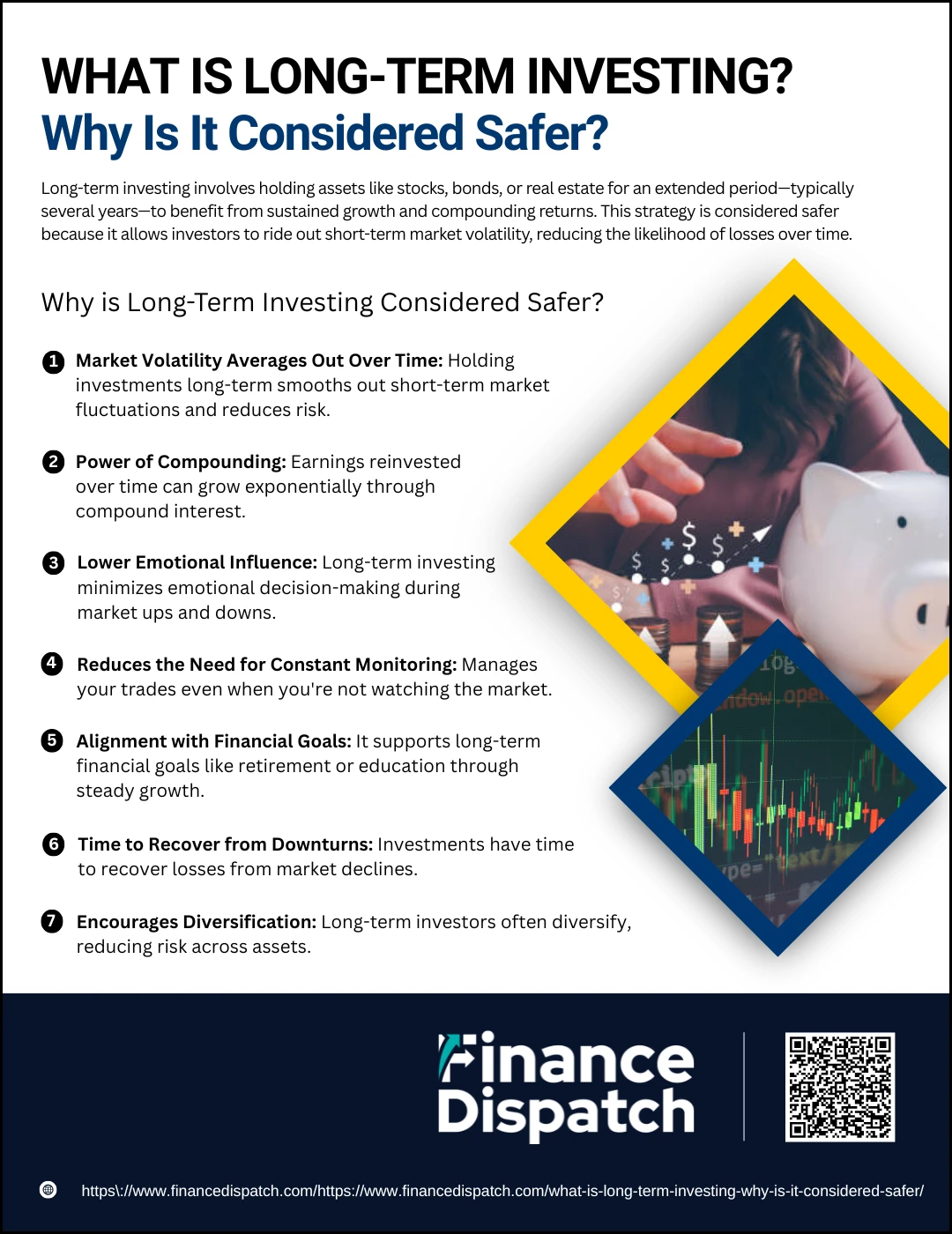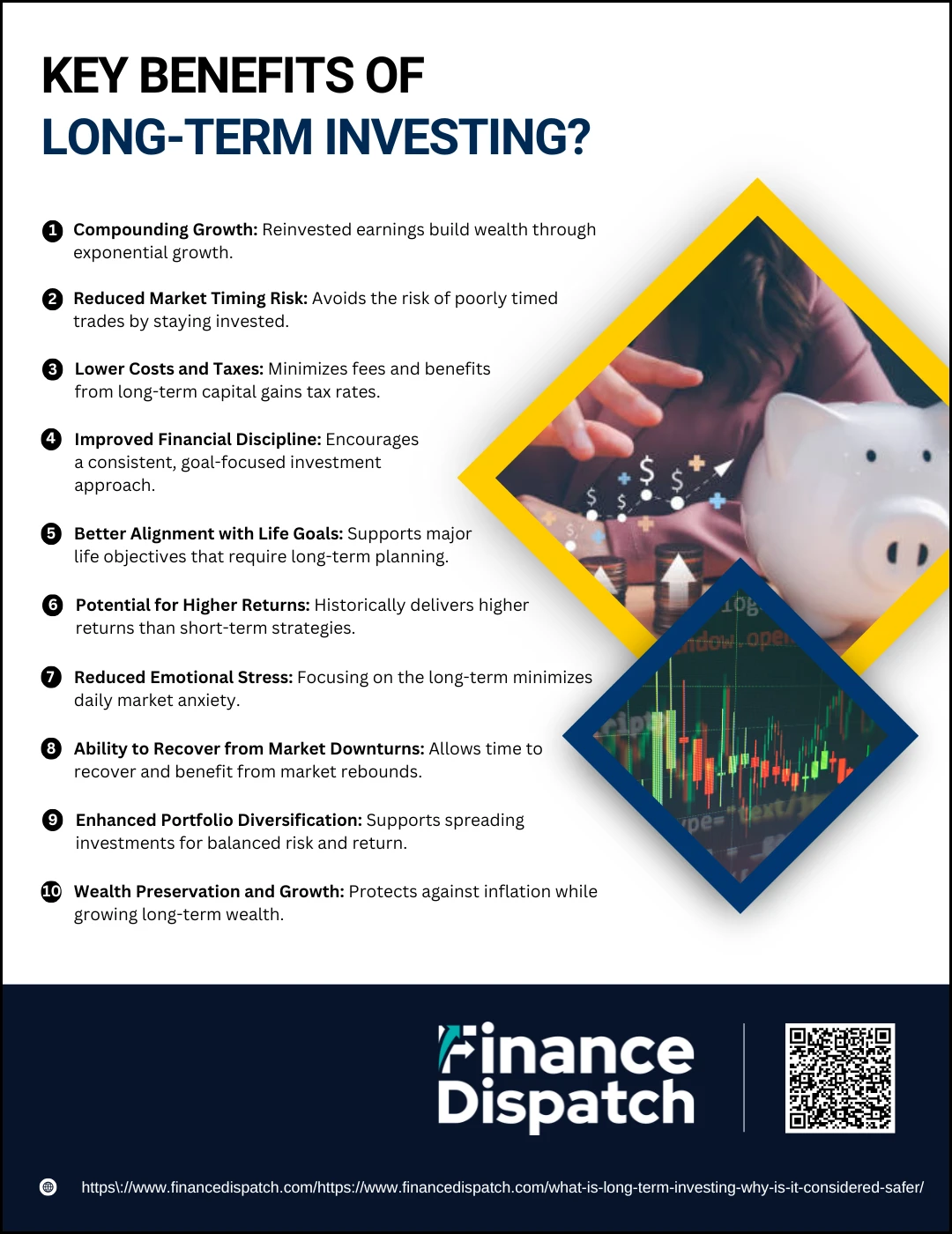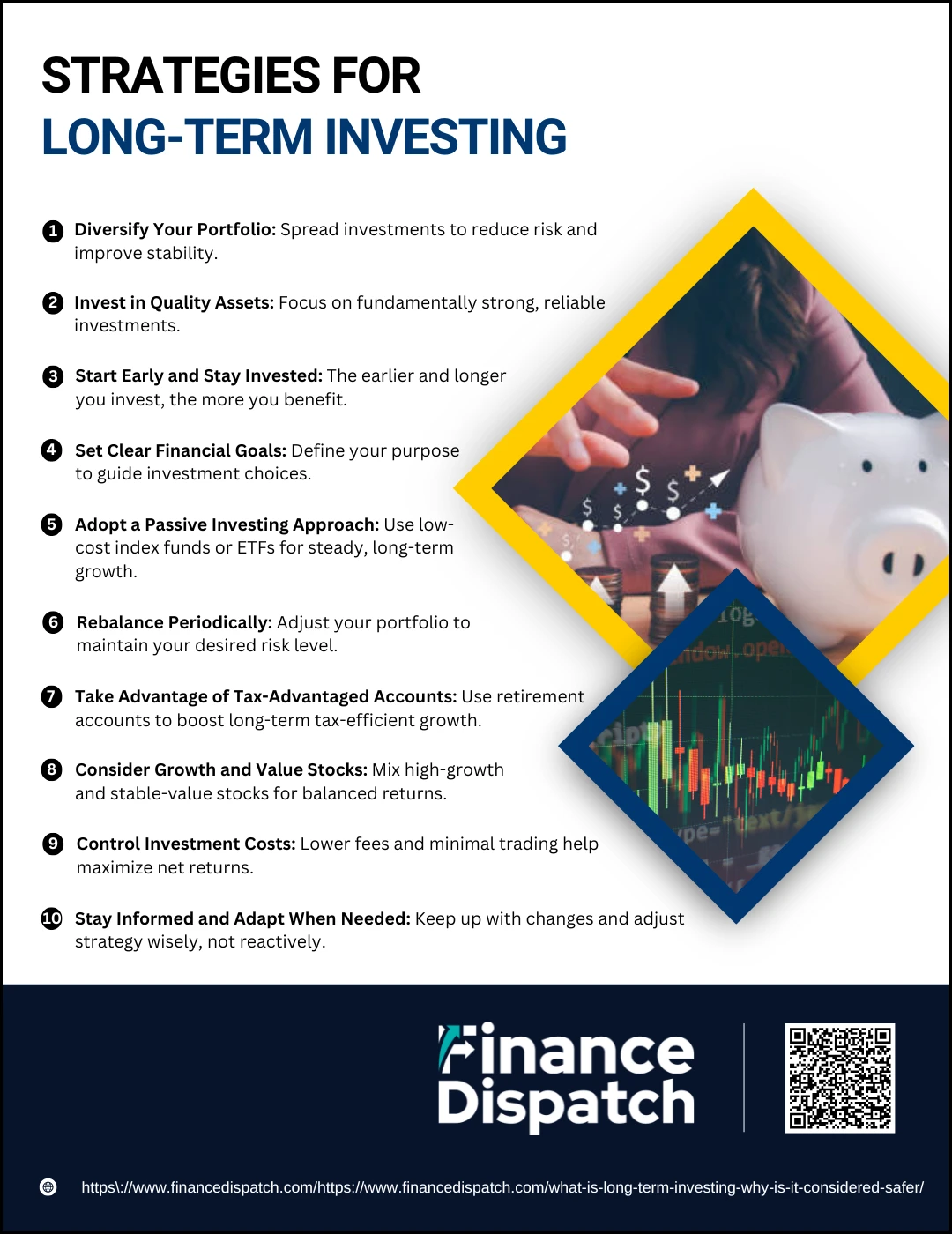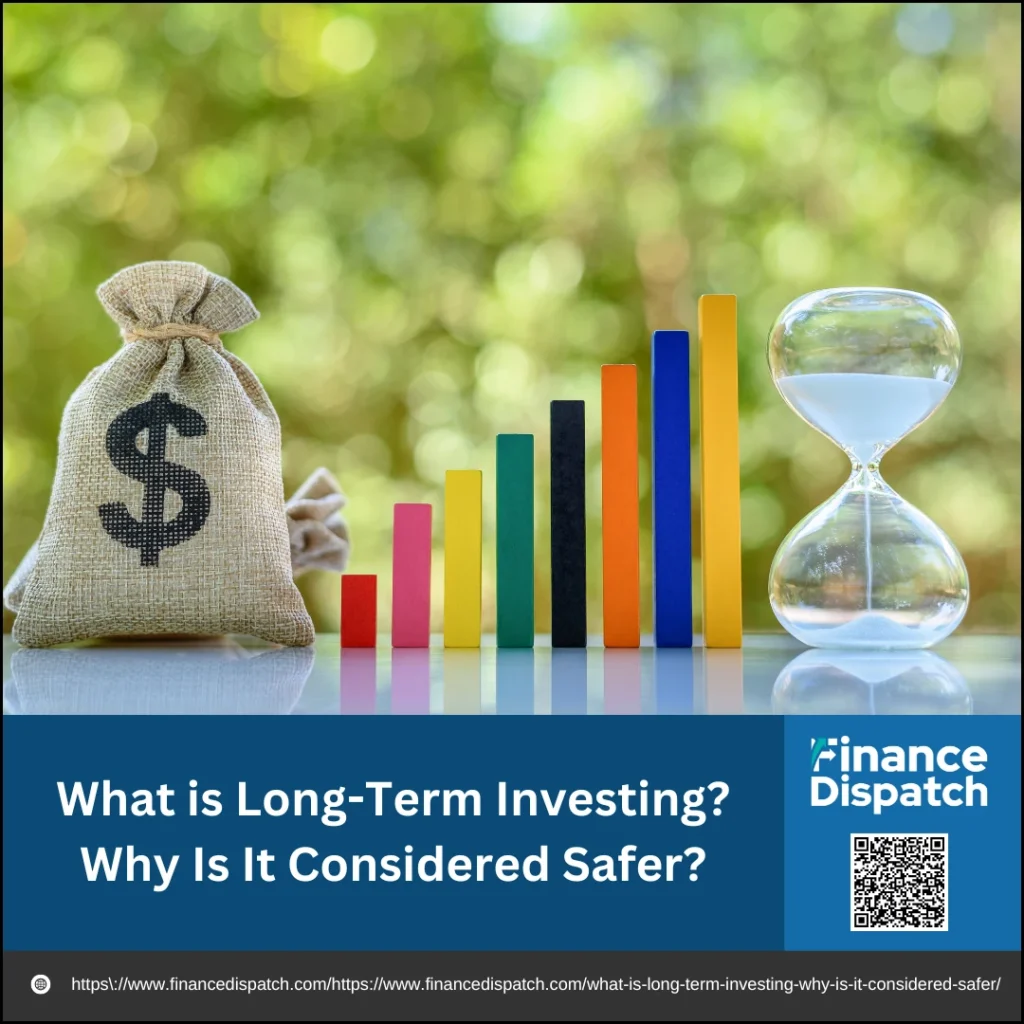Long-term investing is more than just holding onto assets for years — it’s a mindset built on patience, discipline, and a clear vision for future financial goals. Rather than chasing quick profits, long-term investors focus on sustained growth, often weathering short-term market fluctuations with confidence. This approach is widely regarded as safer because it leverages the power of compounding, reduces emotional decision-making, and historically delivers more stable returns. In this article, we explore what long-term investing truly means and why it continues to be a preferred strategy for building lasting wealth.
What is Long-Term Investing?
Long-term investing is a strategy where individuals or institutions commit their money to assets with the intention of holding them for an extended period—typically five, ten, or even more years. The core idea is to allow investments sufficient time to grow in value, riding out short-term market volatility and capitalizing on the overall upward trend of the market over time. Rather than aiming for quick wins, long-term investors focus on fundamental factors such as a company’s financial health, growth potential, or the intrinsic value of an asset. This patient approach often aligns with major life goals like retirement, education funding, or wealth preservation.
 Why is Long-Term Investing Considered Safer?
Why is Long-Term Investing Considered Safer?
Long-term investing is widely regarded as a safer financial strategy because it emphasizes patience, discipline, and resilience over immediate gains. Unlike short-term trading, which seeks to profit from rapid market movements, long-term investing is about weathering the ups and downs and allowing time and compounding to work in your favor. Here’s a closer look at the key reasons why this approach is considered more secure:
1. Market Volatility Averages Out Over Time
Financial markets can be unpredictable in the short term due to economic events, political shifts, or investor sentiment. However, historical data shows that over extended periods, markets generally trend upward. By holding investments through these fluctuations, long-term investors avoid reacting to temporary downturns and benefit when the market rebounds. This reduces the risk of locking in losses due to fear-based decisions.
2. Power of Compounding
One of the biggest advantages of long-term investing is the ability to earn returns on your returns. When dividends or interest payments are reinvested, they begin to generate their own returns. Over time, this compounding effect accelerates growth exponentially. For example, a modest annual return can result in significant wealth accumulation over two or three decades, making time one of the most powerful tools in investing.
3. Lower Emotional Influence
Short-term traders often react emotionally to market swings, making decisions driven by fear, greed, or speculation. This emotional response can lead to poor timing—buying high and selling low. Long-term investing, on the other hand, encourages a more rational and steady approach. Investors stick to their strategy and are less likely to be swayed by temporary market movements, which helps preserve long-term performance.
4. Reduced Trading Costs and Taxes
Frequent buying and selling can accumulate high transaction fees and generate short-term capital gains, which are typically taxed at higher rates. Long-term investors benefit from lower trading activity, reducing brokerage fees and qualifying for long-term capital gains tax rates, which are usually more favorable. This cost efficiency translates into higher net returns over time.
5. Alignment with Financial Goals
Many financial objectives, such as saving for retirement, a child’s education, or buying a home, naturally require a long-term outlook. Investing with these goals in mind allows individuals to build portfolios that grow gradually, without the pressure of needing immediate liquidity. This focused, long-term planning reduces risk and provides a clear purpose behind each investment.
6. Time to Recover from Downturns
All markets experience periods of decline, such as recessions or financial crises. However, investors who stay committed during downturns often recover their losses and eventually see gains. Long-term investing gives portfolios the time needed to bounce back from these declines, especially when supported by a diversified and well-managed strategy.
7. Encourages Diversification
Long-term investors typically spread their capital across a variety of asset classes, industries, and geographic regions. This diversification minimizes exposure to any single risk and helps stabilize returns. If one asset underperforms, others may compensate, balancing the overall portfolio. Over time, a diversified strategy contributes to both risk reduction and steady growth.
Common Long-Term Investment Options
When planning for long-term financial goals such as retirement, education, or wealth preservation, choosing the right investment vehicles is essential. Long-term investments are typically held for several years or decades, allowing them to grow in value over time through appreciation, interest, or dividends. These options are often selected for their potential to offer steady growth and to weather short-term market fluctuations.
Here are some of the most common long-term investment options:
1. Stocks: Investing in individual company shares offers the potential for significant capital growth over time. Historically, stocks have outperformed most other asset classes over long periods.
2. Mutual Funds: These pooled investment vehicles allow you to invest in a diversified portfolio of stocks, bonds, or other securities, often managed by professional fund managers.
3. Exchange-Traded Funds (ETFs)
ETFs are similar to mutual funds but trade on stock exchanges like individual stocks. They offer diversification, lower fees, and are ideal for passive long-term investors.
4. Bonds: Government or corporate bonds provide regular interest income and are generally considered less volatile than stocks, making them a staple in long-term portfolios.
5. Real Estate: Investing in property can offer both income through rent and long-term capital appreciation. It’s also considered a hedge against inflation.
6. Index Funds: These funds track market indexes like the S&P 500 and offer broad market exposure at low cost. They’re a favorite among long-term investors due to their simplicity and consistent performance.
7. Retirement Accounts (e.g., 401(k), IRA): These tax-advantaged accounts are designed specifically for long-term investing and offer various options for holding mutual funds, ETFs, and other assets.
8. Dividend Stocks: Shares of companies that regularly pay dividends can provide steady income and long-term growth when dividends are reinvested.
9. REITs (Real Estate Investment Trusts): REITs allow you to invest in real estate without owning physical property. They typically pay dividends and offer long-term capital gains potential.
10. Gold and Precious Metals: Though not growth-focused, these assets are often used for long-term wealth preservation and as a hedge against economic uncertainty and inflation.
 Key Benefits of Long-Term Investing
Key Benefits of Long-Term Investing
Long-term investing provides a powerful framework for building and preserving wealth. By committing to assets for extended periods—typically five years or more—you allow your investments to grow, recover from downturns, and benefit from the compounding of returns. This patient strategy can yield significant rewards, both financially and emotionally, especially when aligned with personal life goals like retirement or education planning.
Here are the key benefits of long-term investing explained in more detail:
1. Compounding Growth
Compounding allows your investment earnings to generate their own earnings over time. When you reinvest dividends or interest, those additional amounts also begin to earn returns, creating a snowball effect. The longer you stay invested, the more powerful this exponential growth becomes, making time one of the most valuable tools in wealth creation.
2. Reduced Market Timing Risk
Trying to time the market—buying low and selling high—is notoriously difficult and risky. Long-term investors avoid this trap by staying invested regardless of short-term price movements. This reduces the chances of making costly mistakes during market highs or lows and focuses on long-term trends rather than short-term noise.
3. Lower Costs and Taxes
Long-term investing typically involves fewer trades, which means reduced brokerage fees and lower capital gains taxes. In many tax systems, gains on investments held for more than a year are taxed at a lower rate than those held for shorter periods, allowing you to keep more of your profits.
4. Improved Financial Discipline
With a long-term outlook, investors are more likely to follow a structured plan based on their financial goals. This disciplined approach discourages reactive decisions based on market sentiment, helping you stay committed to your strategy through both good times and bad.
5. Better Alignment with Life Goals
Whether you’re saving for retirement, a child’s college education, or a future home, long-term investing aligns well with these objectives. It provides a framework that allows your investments to grow gradually over time, matching the natural timeline of major life events.
6. Potential for Higher Returns
Historically, equities and diversified portfolios have delivered higher average returns over long periods compared to short-term strategies or keeping money in savings. Staying invested through various market cycles increases your chances of capturing this long-term growth.
7. Reduced Emotional Stress
Constantly watching the markets can be emotionally exhausting. Long-term investors, by focusing on the future, are less concerned with daily fluctuations and more focused on big-picture outcomes, reducing stress and emotional burnout.
8. Ability to Recover from Market Downturns
Markets go through cycles, including corrections and recessions. While short-term investors may suffer losses, long-term investors often have the time to wait for markets to recover, turning temporary setbacks into long-term gains.
9. Enhanced Portfolio Diversification
A long-term strategy encourages a diversified investment approach, spreading your money across different asset classes such as stocks, bonds, and real estate. This diversification reduces the impact of poor performance in any one area, making your overall portfolio more stable.
10. Wealth Preservation and Growth
Long-term investments not only grow wealth but also protect it against inflation and erosion of purchasing power. Assets like stocks and real estate have historically outpaced inflation, helping ensure that your money retains its value over the years.
The Risks and Limitations of Long-Term Investing
While long-term investing is widely praised for its stability and potential for substantial returns, it is not without its challenges. Holding assets over extended periods requires discipline and patience, but it also comes with certain risks and limitations that investors must understand. Knowing these drawbacks can help you make more informed decisions and manage expectations more realistically.
Here are the key risks and limitations of long-term investing:
1. Market Volatility and Economic Downturns: Although long-term strategies aim to smooth out short-term fluctuations, major events like recessions, geopolitical crises, or financial crashes can still have lasting effects on investment value.
2. Inflation Risk: Over time, inflation can erode the purchasing power of your returns. If your investments don’t outpace inflation, you might end up with less real value despite nominal gains.
3. Liquidity Constraints: Long-term investments often involve locking away capital for years. This lack of access can be a disadvantage if you suddenly need funds for emergencies or opportunities.
4. Opportunity Cost: Committing money to long-term holdings means missing out on potentially lucrative short-term investments or other uses for that capital.
5. Interest Rate Sensitivity: Some long-term assets, especially bonds or growth stocks, are sensitive to changes in interest rates. Rising rates can reduce the present value of future returns, impacting overall performance.
6. Uncertain Future Performance: Past performance is no guarantee of future returns. Even assets that have performed well historically may underperform due to changes in the market, industry disruption, or poor management.
7. Behavioral Risks: Staying committed to a long-term strategy requires emotional discipline. Market downturns or slow periods can tempt investors to make impulsive changes that could hurt long-term results.
8. Changing Personal Circumstances: Life events—such as job loss, health issues, or family needs—can alter your financial goals or risk tolerance, making your original investment plan less suitable over time.
9. Regulatory or Political Changes: New laws, tax regulations, or political shifts can affect entire industries or asset classes, impacting the performance of long-term investments.
 Strategies for Long-Term Investing
Strategies for Long-Term Investing
A successful long-term investment journey doesn’t happen by accident—it requires a thoughtful strategy tailored to your financial goals, risk tolerance, and time horizon. Long-term investing isn’t just about buying and holding; it’s about making smart decisions that position your portfolio for growth while managing risks. The right strategy can help you navigate market fluctuations, seize opportunities, and stay focused on the bigger picture.
Here are some effective strategies for long-term investing:
1. Diversify Your Portfolio
Spread your investments across different asset classes—such as stocks, bonds, real estate, and mutual funds—to reduce overall risk. Diversification helps ensure that poor performance in one area doesn’t significantly impact your entire portfolio.
2. Invest in Quality Assets
Choose investments based on strong fundamentals, such as companies with stable earnings, competitive advantages, and solid growth potential. High-quality assets tend to perform better over the long run and recover faster from market downturns.
3. Start Early and Stay Invested
The earlier you begin investing, the more time your money has to grow through compounding. Staying invested over the long term—even through market volatility—can lead to greater wealth accumulation than frequent trading.
4. Set Clear Financial Goals
Define what you’re investing for—whether it’s retirement, a home, or a child’s education. Having specific goals helps determine your investment horizon and risk tolerance, guiding your asset allocation and investment choices.
5. Adopt a Passive Investing Approach
Consider low-cost index funds or ETFs that track the market over time. Passive investing minimizes trading activity and management fees, making it a cost-effective option for long-term wealth building.
6. Rebalance Periodically
Over time, your portfolio may drift from its original asset allocation due to market performance. Rebalancing ensures that your risk level remains aligned with your goals by adjusting your holdings back to their target proportions.
7. Take Advantage of Tax-Advantaged Accounts
Use retirement accounts like IRAs or 401(k)s to invest for the long term. These accounts offer tax benefits that can enhance returns and support disciplined saving habits.
8. Consider Growth and Value Stocks
Blend growth stocks, which offer high potential returns, with value stocks, which provide stability and dividends. This combination can balance risk and reward over long periods.
9. Control Investment Costs
Choose investment options with low expense ratios, avoid unnecessary trading, and be mindful of fees. Lower costs leave more of your returns working for you over time.
10. Stay Informed and Adapt When Needed
While long-term investing is about consistency, it’s still important to stay informed about changes in the economy, markets, or personal circumstances. Adjust your strategy when major shifts occur but avoid reacting to short-term noise.
Tips to Succeed as a Long-Term Investor
Long-term investing is a proven path to building lasting wealth, but it requires more than just holding onto assets for years. Success comes from making smart decisions, maintaining discipline, and staying aligned with your financial goals. By following some essential best practices, you can maximize your returns, minimize risks, and stay confident in your investment journey—even during turbulent market conditions.
Here are some practical tips to help you succeed as a long-term investor:
1. Define Clear Financial Goals: Knowing what you’re investing for—such as retirement, a home purchase, or your child’s education—helps shape your strategy and keeps you focused over time.
2. Start Early and Be Consistent: The earlier you begin investing, the more time your money has to grow. Consistent contributions, even in small amounts, can lead to significant growth thanks to compounding.
3. Invest Within Your Risk Tolerance: Understand how much risk you’re comfortable with and choose investments accordingly. A portfolio that matches your risk profile helps you stay committed during market downturns.
4. Focus on Long-Term Fundamentals: Choose investments based on their intrinsic value and long-term growth potential, not short-term trends or market hype.
5. Diversify Across Asset Classes: Spread your investments across stocks, bonds, real estate, and other asset types to reduce exposure to any single risk and enhance portfolio stability.
6. Avoid Market Timing: Trying to predict market highs and lows often leads to poor decisions. Stick to your plan and let time, not timing, work in your favor.
7. Reinvest Dividends and Returns: Reinvesting income from dividends or interest helps accelerate portfolio growth through the power of compounding.
8. Monitor and Rebalance Periodically: Review your portfolio at regular intervals and make adjustments if necessary to maintain your desired asset allocation.
9. Minimize Costs and Fees: Choose low-cost investment options and avoid frequent trading. Lower fees mean more of your returns stay in your pocket.
10. Stay Informed but Patient: Keep up with financial news and market trends, but don’t let short-term events shake your long-term conviction. Patience is key to riding out volatility and staying on track.
Long-Term vs Short-Term Investing
When building an investment strategy, one of the first decisions you’ll face is whether to focus on long-term or short-term investing. Each approach comes with its own advantages, risks, and purposes. Long-term investing is generally aligned with goals like retirement and wealth accumulation, while short-term investing is often geared toward quick profits or liquidity. Understanding the differences can help you choose the right strategy—or blend of both—that matches your financial goals and risk tolerance.
Here’s a comparison of long-term and short-term investing:
| Aspect | Long-Term Investing | Short-Term Investing |
| Time Horizon | Typically 5 years to several decades | Days, weeks, or a few months |
| Goal | Wealth accumulation, retirement, education, financial security | Quick profits, taking advantage of price fluctuations |
| Risk Level | Lower (due to time to recover from downturns) | Higher (market timing and short-term volatility) |
| Market Sensitivity | Less sensitive to short-term market swings | Highly sensitive to daily news and market movements |
| Investment Style | Buy-and-hold, passive, strategic | Active trading, speculative |
| Costs and Taxes | Lower due to fewer trades and long-term tax rates | Higher due to frequent trades and short-term capital gains |
| Emotional Pressure | Lower, as patience is key | Higher, due to constant monitoring and decision-making |
| Typical Assets | Stocks, index funds, mutual funds, real estate, bonds | Forex, options, cryptocurrencies, volatile stocks |
| Compounding Benefit | High, due to reinvestment and time | Limited, due to short holding periods |
| Monitoring Frequency | Occasional rebalancing | Daily or even hourly tracking and action |
Conclusion
Long-term investing is more than just a strategy—it’s a mindset rooted in patience, discipline, and a clear focus on future goals. While it may not offer the thrill of quick gains, its potential for sustained growth, reduced risk, and wealth preservation makes it a reliable path for most investors. By understanding its benefits, recognizing its limitations, and applying proven strategies, you can build a solid foundation for financial security. Whether you’re saving for retirement, a home, or future education, long-term investing empowers you to grow your wealth steadily and confidently over time.



